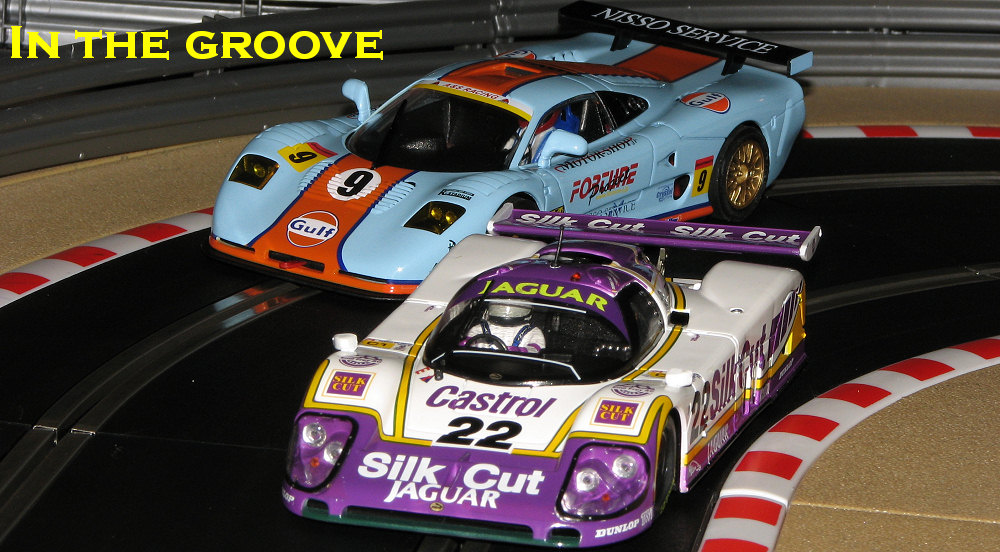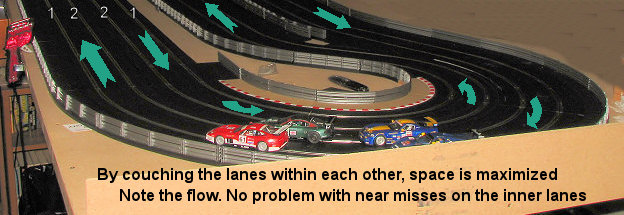

Track
Those of us who have become interested in slot cars have undoubtedly started in the hobby by buying one of the various racing sets or having one given as a present. I know that my first one was by AMT. It consisted of two 1/25 1965 Fords and an oval track. It had a rather novel way of keeping the cars in the slot. Instead of the usual groove with two metal strips providing power to a piece of braided wire, this one had a small carriage that fit into the slot. This carriage stayed in the slot and drew power from metal strips on the side of the slot. At track level, there was a swivel attachment that fit into an opposite attachment on the bottom of the front of the car. In this way, it was impossible for the car to de-slot. It was controlled by a steering wheel/throttle set up that required just the right turn of the wheel to keep power to the car while going through the corners. It made for some very interesting play, but these parts were not as rugged as one would like and in a very short time the set was no longer viable. While the cars and controllers are gone, I still have the track up in my attic.
Realizing that the hobby was fun, but the original method was lacking, the next set was by Strombecker. This had a ‘real’ slot car set, which consisted of a rubberized body, plastic chassis, skinny tires on plastic wheels and an open Pittman type motor. The bodies just snapped on and while the cars were not at all fast, these were authentic slot cars and my Ferrari Testa Rosa and Jaguar D had many battles on the figure 8 track that came with the set.
Eventually, I wanted more track and so switched to Aurora HO. In the same space that the 1/32 Strombecker track fit, I could put many times as much Aurora track. It eventually ended up on a 4X8 Plywood board in a somewhat replica of Road America and stayed that way for many year.
Meanwhile, my tastes in larger cars switched to 1/24 and my father was kind enough to drop me off at local commercial or routed tracks for an afternoon of slot car mayhem until I was old enough to drive myself there. But that is getting a bit off track.
Forward the way-back machine from 1966 to 2007.
The bug bites again. This time, the hobby has really grown and is a lot more sophisticated in terms of tracks and cars. The hobbyist has a choice between the new digital racing (which allows several cars on the same lane) or standard. Digital has an allure, but like the HiDef situation, once you choose a platform, you are stuck with it and other digital cars won’t work. It also prevents normal analog cars from operating on the track. Personally, I’d wait a few more years for things to even out before going the digital route.
So then it was a choice of which track brand to get.
Basically, there are five main companies that produce sets in 1/32. Artin, Carrerra, Ninco, SCX, and Scalextric. All of them have their proponents. Generally speaking, the Carrera track is larger in terms of the space it will take up when compared to the others. Some offer digital set-ups if that is your liking.
I read all I could about the different brands. They all have websites so a google will get you information. One thing I did notice was that Scalextric and Carrera seemed to have a wider variety of track than the others. Since I wanted to maximize the space, I chose a Scalextric set. The current track is what’s known as ‘Sport’. It basically differs from the ‘Classic’ by having a slightly deeper slot, a smoother surface, and is much easier to connect sections together. The two tracks can be used together with conversion pieces if you already have the older stuff or can get it cheap.
During all this, I also prowled Evil-bay for people selling sets that didn’t have cars and picked up a couple at a very reasonable price. This is the best way to get more track at a low cost. Once I got all the track, I looked for a place to set things up. In my basement is a bar that my father built, but was getting no use aside from a place to set junk. I decided that this is where I’d build my first track. It is a bit taller than what is suggested at 45 inches from the floor (36 or less being the norm), but it provided a stable platform and was the largest free space I had.
I bought a sheet of ½ inch 4 x 8 foot particle board and braced it around the edges and through the middle with 2x2s that were out in my garage. I have a ton of lumber out there from various projects so buying wood wasn’t really a necessity, though I did have to buy particle board. It made for a rather heavy chunk, but I was able to lift it into place atop the bar and immediately started plunking down track. By worming things around, I got a rather twisty track that covered around 25 feet or so.
Well, that really wasn’t going to cut it for long as the cars barely had time to build up any speed before they hit corners. I then got another 4x8 sheet of particle board. This was then bolted to the other one length wise using ¼ inch 3 ½ inch long bolts. By bolting everything, it means it can more easily be taken down if the need arises.
 This made for a 4x16 foot track
base and provided some nice long straight sections and a few twisty bits. By
couching two of the sweeping turns inside each other, I was able to get some
decent overall track length. Made better use of the track that I’d bought. This
second piece needed to have some legs so I used a few 1x2s that I had in the
lumber stash. Proved to be too thin after one broke so I used 2x4s. These were
also bolted in place with ¼ inch bolts.
This made for a 4x16 foot track
base and provided some nice long straight sections and a few twisty bits. By
couching two of the sweeping turns inside each other, I was able to get some
decent overall track length. Made better use of the track that I’d bought. This
second piece needed to have some legs so I used a few 1x2s that I had in the
lumber stash. Proved to be too thin after one broke so I used 2x4s. These were
also bolted in place with ¼ inch bolts.
I now had a track that was long enough to handle my speed fix. But as you all know, things are never fully static and there was more expansion to come.
If you’d like to share some of your experiences or photos of your cars or track, please e-mail me at mmreaders@aol.com. I can’t promise to get back to you quickly or that your images will be published, but who knows!
Scott